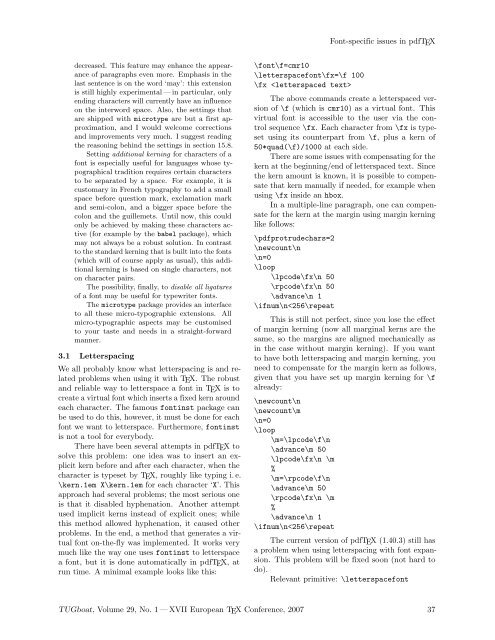Complete issue 29:1 as one pdf - TUG
Complete issue 29:1 as one pdf - TUG
Complete issue 29:1 as one pdf - TUG
You also want an ePaper? Increase the reach of your titles
YUMPU automatically turns print PDFs into web optimized ePapers that Google loves.
Font-specific <strong>issue</strong>s in <strong>pdf</strong>TEX<br />
decre<strong>as</strong>ed. This feature may enhance the appearance<br />
of paragraphs even more. Emph<strong>as</strong>is in the<br />
l<strong>as</strong>t sentence is on the word ‘may’: this extension<br />
is still highly experimental — in particular, only<br />
ending characters will currently have an influence<br />
on the interword space. Also, the settings that<br />
are shipped with microtype are but a first approximation,<br />
and I would welcome corrections<br />
and improvements very much. I suggest reading<br />
the re<strong>as</strong>oning behind the settings in section 15.8.<br />
Setting additional kerning for characters of a<br />
font is especially useful for languages whose typographical<br />
tradition requires certain characters<br />
to be separated by a space. For example, it is<br />
customary in French typography to add a small<br />
space before question mark, exclamation mark<br />
and semi-colon, and a bigger space before the<br />
colon and the guillemets. Until now, this could<br />
only be achieved by making these characters active<br />
(for example by the babel package), which<br />
may not always be a robust solution. In contr<strong>as</strong>t<br />
to the standard kerning that is built into the fonts<br />
(which will of course apply <strong>as</strong> usual), this additional<br />
kerning is b<strong>as</strong>ed on single characters, not<br />
on character pairs.<br />
The possibility, finally, to disable all ligatures<br />
of a font may be useful for typewriter fonts.<br />
The microtype package provides an interface<br />
to all these micro-typographic extensions. All<br />
micro-typographic <strong>as</strong>pects may be customised<br />
to your t<strong>as</strong>te and needs in a straight-forward<br />
manner.<br />
3.1 Letterspacing<br />
We all probably know what letterspacing is and related<br />
problems when using it with TEX. The robust<br />
and reliable way to letterspace a font in TEX is to<br />
create a virtual font which inserts a fixed kern around<br />
each character. The famous fontinst package can<br />
be used to do this, however, it must be d<strong>one</strong> for each<br />
font we want to letterspace. Furthermore, fontinst<br />
is not a tool for everybody.<br />
There have been several attempts in <strong>pdf</strong>TEX to<br />
solve this problem: <strong>one</strong> idea w<strong>as</strong> to insert an explicit<br />
kern before and after each character, when the<br />
character is typeset by TEX, roughly like typing i. e.<br />
\kern.1em X\kern.1em for each character ‘X’. This<br />
approach had several problems; the most serious <strong>one</strong><br />
is that it disabled hyphenation. Another attempt<br />
used implicit kerns instead of explicit <strong>one</strong>s; while<br />
this method allowed hyphenation, it caused other<br />
problems. In the end, a method that generates a virtual<br />
font on-the-fly w<strong>as</strong> implemented. It works very<br />
much like the way <strong>one</strong> uses fontinst to letterspace<br />
a font, but it is d<strong>one</strong> automatically in <strong>pdf</strong>TEX, at<br />
run time. A minimal example looks like this:<br />
\font\f=cmr10<br />
\letterspacefont\fx=\f 100<br />
\fx <br />
The above commands create a letterspaced version<br />
of \f (which is cmr10) <strong>as</strong> a virtual font. This<br />
virtual font is accessible to the user via the control<br />
sequence \fx. Each character from \fx is typeset<br />
using its counterpart from \f, plus a kern of<br />
50*quad(\f)/1000 at each side.<br />
There are some <strong>issue</strong>s with compensating for the<br />
kern at the beginning/end of letterspaced text. Since<br />
the kern amount is known, it is possible to compensate<br />
that kern manually if needed, for example when<br />
using \fx inside an hbox.<br />
In a multiple-line paragraph, <strong>one</strong> can compensate<br />
for the kern at the margin using margin kerning<br />
like follows:<br />
\<strong>pdf</strong>protrudechars=2<br />
\newcount\n<br />
\n=0<br />
\loop<br />
\lpcode\fx\n 50<br />
\rpcode\fx\n 50<br />
\advance\n 1<br />
\ifnum\n

















